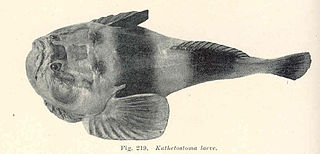
The stargazers are a family, Uranoscopidae, of perciform fish that have eyes on top of their heads. The family includes about 51 species in eight genera, all marine and found worldwide in shallow and deep saltwaters.

Double anglers are a family, Diceratiidae, of anglerfishes. They are found in deep, lightless waters of the Atlantic, Indian and western Pacific Oceans.

Krøyer's deep sea angler fish is a species of fish in the family Ceratiidae, the sea devils. This deep-sea anglerfish is found in all oceans, at depths of 0 to 4,400 m, but mainly between 400 and 2,000 m. Females typically are 77 cm (2.53 ft) long, but can reach 120 cm (3.9 ft). The much smaller males only reach 16 cm (0.52 ft) and they are symbiotic, as they attach themselves to a female.

Venomous fish produce strong mixtures of toxins harmful to humans which they deliver by means of a bite, sting, or stab. This results in an envenomation. As a contrast, poisonous fish also produce a strong toxin, but they do not bite, sting, or stab to deliver the toxin. Instead they are poisonous to eat because the human digestive system does not destroy the toxin they contain in their body. Venomous fish don't necessarily cause poisoning if they are eaten, since the digestive system often destroys the venom.
A blind fish is a fish without functional eyes. Most blind fish species are found in dark habitats such as the deep ocean, deep river channels and underground.
Raphael catfish may refer to a number of different South American doradid catfish species:

The giant talking catfish or giant raphael catfish is a species of thorny catfish that is native to the Amazon Basin in Bolivia, Brazil, Colombia, Ecuador and Peru. This species grows to a length of 60 centimetres (24 in) SL and a maximum weight of 4.6 kilograms (10 lb). These fish are a component of local commercial fisheries.

Romanogobio uranoscopus, alternatively known as the Danubian longbarbel gudgeon, Danubian gudgeon, Danube gudgeon or the steingressling, is a European species of freshwater cyprinid fish. It can be found in Austria, Bulgaria, Croatia, Czech Republic, Germany, Hungary, Italy, Romania, Serbia and Montenegro, Slovakia, Slovenia and Ukraine.
The skygazer shiner is a small-sized cyprinid fish species found in the Alabama River drainage in Alabama, USA.
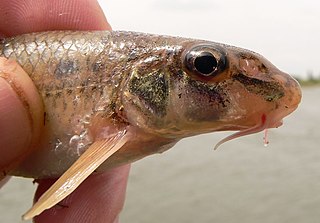
Romanogobio is a genus of cyprinid fish found in Europe and Asia. There are currently 18 described species in this genus, including the extinct R. antipai.
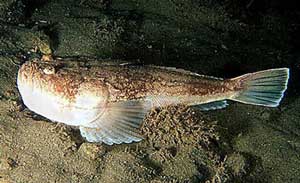
Uranoscopus is a genus of stargazer fish from the family Uranoscopidae. The name Uranoscopus is from the Greek, ouranos, "sky" and skopein, "to watch".

Dollfus' stargazer is a fish of the family Uranoscopidae, widespread in the Western Indian Ocean: Gulf of Suez, Gulf of Oman, and Persian Gulf. It is a marine demersal fish, and occurs at depths down to about 46 metres (151 ft). It was named in honour of Dr R. P. Dollfus who led an expedition to Egypt in 1928–1929 and who brought back some specimens of this fish which he mistakenly identified as Uranoscopus affinis. These were new to science and became the type specimens of the new species U. dollfusi, with the Gulf of Suez being the type locality.
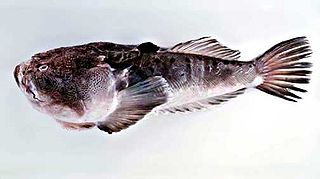
Whitemargin stargazer is a fish of family Uranoscopidae, widespread in the Indopacific: Red Sea, Indonesia, Fiji, Samoa, and Tonga. Marine reef-associated fish, up to 45.0 cm maximal length.
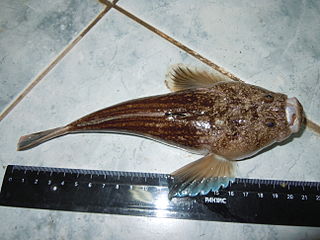
Atlantic stargazer is a marine, subtropical fish of family Uranoscopidae. Its body is suited for living on the sea floor, and is one of few fish capable of bioelectrogenesis, or the ability to generate an electric charge.

Ceratias is a small genus of seadevils.

Trachicephalus uranoscopus, the star-gazing stonefish, is a species of stonefish native to the Indian Ocean and the western Pacific Ocean where it is found on muddy bottoms in estuaries. This venomous species is also a minor component of local commercial fisheries. This species grows to a length of 8 centimetres (3.1 in) SL. This species is the only known member of the genus Trachicephalus.

Ceratia is a genus of sea snails, marine gastropod mollusks the family Iravadiidae.
Ceratias tentaculatus, commonly known as the southern seadevil, is a species of sea devil, a type of anglerfish. The fish is bathydemersal and can be found at depths ranging from 100 to 2,900 metres. It is endemic to the Southern Ocean.

Thalassophryne maculosa, the Cano toadfish, is a species of toadfish which is common along the Caribbean coasts of South America from Colombia to Trinidad and Venezuela. It occurs on the sandy bottoms of reef flats, lagoons, and seaward edges of reefs where it sits partially buried in the substrate. It is a venomous species with the venom being delivered through spines and wounds from the spines have been known to cause severe symptoms of pain and illness that may persist for up to a week. A study of the holotype of Batrachus uranoscopus, said to be a freshwater toadfish from Madagascar, in the Muséum national d’Histoire Naturelle in Paris found that it was most probably a misslabelled specimen of Thalassophryne maculosa and that subsequent records of Batrachus uranoscopus were attributable to Allenbatrachus meridionalis, a species found in Madagascar. T. maculosa is the type species of the genus Thalassophryne, the generic name translates from Greek as "sea toad" while the specific name is Latin for "spotted".


















